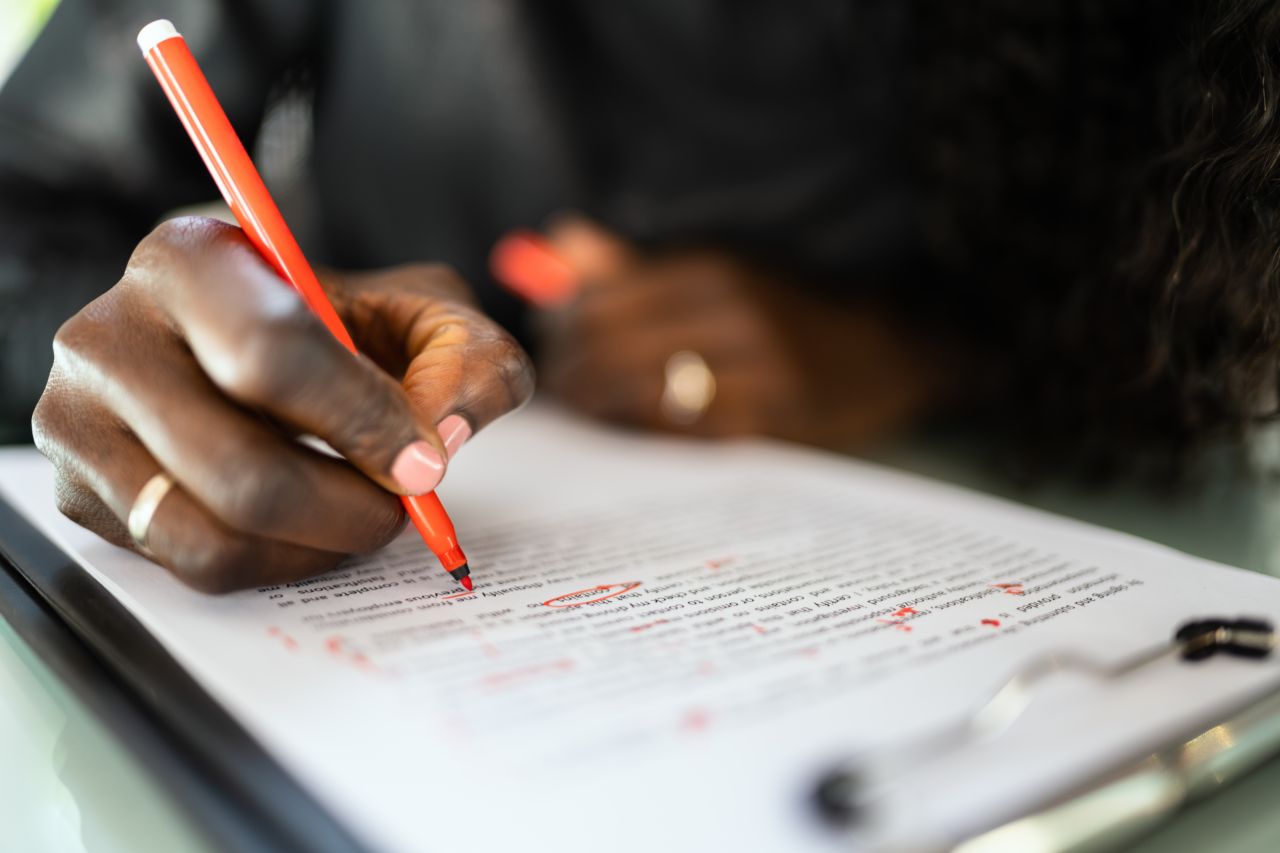Proofread yourself smart in three easy steps to deliver awesome copy
Here is a quick guide to delivering error-free work, even when you have no one handy to read your stuff. Proofreading is a vital skill for everyone, no exceptions. If you don’t master it, you’ll wind up looking a fool.

Image licensed via Adobe Stock
Typos take the sheen off any work. Whether it’s an article, a pitch or a slither of packaging copy, anything with typos makes you come across like you don’t know or you don’t care. Is your proofreading prowess holding you back?
Now, a little disclaimer: we all make mistakes. That’s why they put rubbers on pencils. Nobody is perfect. I’ve embarrassed myself a fair few times. But much less so now, mainly since I developed a system to follow before a client sees a draft:
- Get to grips with style rules
- Give your writing an out-of-body experience
- Font Swapping – the deadliest weapon against typos.
1.1. Know your punctuation and house style
First things first, know what you are looking for. A reasonable command of grammar and punctuation is useful: see these tricky punctuation rules that could be killing your credibility.
Then there’s an extra layer of rules: house style.
I got my first copywriting training at Vodafone, and we were taught that clear communication is way more important than antiquated laws of language. After all, language is a continually evolving beast (and vast swathes of their customers don’t-know-don’t-care about grammar).
I’ve worked in companies who paid top dollar to big advertising agencies to tell us it wasn’t hip to put full stops in "i.e." and "e.g." anymore… we should step out of the dark ages and ditch those dots… it felt weird at first, I’ve got to say, that looked pretty sweet on glossy brochures.
But I’ve made the mistake of leaving said dots out, when ghosting an opinion piece for a corporate lawyer, presenting him with a first draft with "eg" and "ie" – he wasn’t having that! He let me know, in an oh-so-British passive-aggressive email. Very polite, but in his way, he tore me a new ‘un.
So follow or create a style guide that suits your audience expectations.
If your customers value trendy design over tradition, you might ‘cut corners’, to show how bold and current you are.
I’ve read decent novels that don’t bother with speech marks, and Ten Storey Love Song by Richard Millward is presented as a single paragraph (and you don’t long for a line break, at all). Which goes to show, you can mix it up: there is artistic licence in punctuation.
For example, single versus double speech marks is pretty flexible, as are brackets [but use square brackets to add Ed’s notes only].
You need a fixed house style policy on whether to use a dash or a bracket, whether you view a job title as a proper noun and capitalise, what you think of American Zees etc. etc.
What matters most is absolute consistency. If you are wildly breaking the rules or adhering to them with a vengeance, you have to know why – and be prepared to defend your position against grammar fundamentalists.
If in doubt, stick to an old school style guide like Oxford Guide to Style.
1.2. Know your grammar stumbling blocks
You’ve got less flexibility with grammar. Most grammar fails are about using the wrong word for the job.
Check out our essential checklist of 140 words you could be getting wrong to identify your blind-spots and keep a beady eye on them.
Not included in that list are the little niggles, often tricky-to-remember mistakes such as:
Should have / Should of
Easy, this one: There’s no such thing as should of / would of / could of. It’s that simple. By all means, say ‘should of’ if that’s how your accent works, but never write it down.
You’re / Your
If they are something, use the apostrophe and contraction. If they own something, then it’s your – even if the thing that’s being owned is behaviour, for example:
Your table manners are truly shocking, Mr Wickham
Sod off, Darcy. You’re only trying to impress Ms Bennett.
There / Their / They’re
If you’re talking about a place, it’s there. If someone owns it, think ‘the I R’ – standing for ‘THE Individuals’ Rightful’ – that’s their.
They’re works when somebody is something: it is a contraction of they are.
For example: I love Canadian chips and gravy. They’re very passionate about their poutine over there.
Fewer vs. Less
If you can count it – i.e. pints of beer – then put fewer.
For example: I could have done with sinking a few fewer pints last night.
Or if it’s in the singular, go for less – i.e. I wish I’d have drank less beer.
The exception is with lump sums: i.e. weight, time, distance. If you are dealing in lump sums, such as amounts of dollars, kilograms or miles, always use less.
NB: I think fewer vs. less could be on the endangered species list, along with who and whom. I wonder if we’ll be bothering with them in 20 years. My gut feel is not.
Which / That
A lot of the time these are interchangeable but watch out for something called a restrictive clause, which means a situation where you bash in a comma to show that you’re explaining yourself.
For example: This is an article about proofing, which means epic typos are bound to happen.
So use which and that, however, feels best, but remember, if they immediately follow a comma, go for which. Simples.
2. Read aloud to bust silly mistakes
Of the grammar mistakes that don’t involve dropping in an incorrect word, some are generally not worth worrying about, e.g. splitting infinitives (that rule comes from Latin, which is long dead unless you’re writing in science or legal, for the Pope, or football club mottos).
Others such as dangling modifiers and incomplete comparisons sound so ridiculous out loud that you will automatically notice and correct them if you take the time to read aloud.
Reading aloud is a vital part of the editing process.
Words are an oral tradition. The notion that most people can read and write is new, in the grand scheme of things. Words are sounds, and they are perceived as sound in people’s heads.
Reading aloud is like a dress rehearsal for the real thing. It's the only way to feel your words as the reader will. If you don’t read aloud, the final result could end up sounding clunky.
3. Font swapping – your secret weapon
After a few reads over, your eyes will see what they want to see. You’ll get a bad case of the word blindness and you can proof-read no more. You might consider passing it on to a colleague, but you might not have one suitable or trustworthy to hand – or as a freelancer, you might not have anyone to turn to at all.
Enter the neatest proofreading trick you’ll ever see — font swapping.
The quickest, deadliest weapon in the war against typos. It works the same way as printed copy, but it’s free, environmentally sound and oh so simple. Follow these instructions:
- If you’re using MS Word, in View, zoom in to 200%
- Control +A to highlight all text
- Change the font to something completely different – I write in Georgia, so for proofreading I switch to Berlin, or Verdana usually
- Read through to see how many new errors are revealed.
Font swapping works over and over again. Every time you go once-more-from-the-top, changing the size is a good idea too. Switching to 150% and a new font will cure the word blindness and give you fresh eyes once more.
Another tip is putting the non-printing markers ¶ to show if you’ve got too few or too many spaces – it can be tough to tell in some fonts.
One last look
Now it’s time to put the words into their ultimate format. A designed up PDF, a webpage, whatever. Changing format means you get one last look where you’re able to edit with fresh eyes: after that, your proofreading capabilities will only rejuvenate by leaving a significant amount of time in between reads.
Reading backwards deserves a mention: for short copy, it’s worth a go. But it’s far too slow and cumbersome for longer pieces.
This stage is the moment to pass it round to colleagues and clients. But if you’ve taken care with your rules and regs and font swapping, there shouldn’t be any significant boo-boos.
One last takeaway – never proofread when you're tired! That’s just asking for trouble.

























